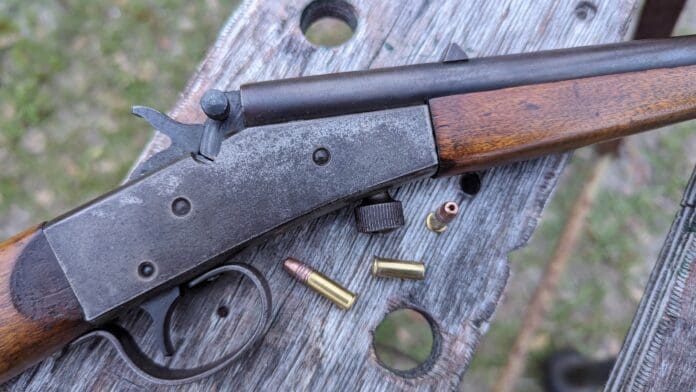
A long time ago, when I was a young man at the School of Infantry, an instructor told us we were apes. He talked about how, with female Marines, he could explain to them how to do something, and they could typically do it. He told us guys that, as apes, we had to learn in a more tactile manner. I don’t know if it’s true that all men learn better with the item in their hand, but I do. I wanted to experience the difference between a rolling block and a falling block. Instead of reading about it online, I purchased a Remington Model 4 and a Stevens Little Scout 14.5 and figured it out myself.

The difference was pretty darn simple, and I ended up having two very fun rimfire firearms. I like the Remington, but since it’s limited to .22 Short and Long, I don’t find myself shooting it as often as the Stevens Little Scout 14.5 in .22 LR. The Stevens Little Scout 14.5, hereby known as the Little Scout, is a falling block rimfire rifle. Stevens made an entire series of these rifles. They fell into the genre of Boy’s Rifles.
The Stevens Boy’s Rifles
Back when we were a proper country, gun makers could produce firearms for kids with the idea of teaching gun safety and marksmanship as a skill. If you do that these days, you’ll have Chuck Schumer calling on the FTC to come after you. I wish I was joking, but I’m not. Hell, you can’t even advertise a short stock as a youth stock anymore. You’ll need to call it a Bantam stock. Rant over, but I’ve gotten into collecting these Boy’s rifles and find them to be fascinating. Plus, they tend to be plenty affordable. The falling block Little Scout is just one of many.


The Stevens family of falling block Boy’s rifles is made up of 14 rifles that started with the No. 12 and ended with the No. 71. They skipped a few numbers but ended up giving us two 14s. The 14 and the 14.5. The differences include caliber. The 14 chambered the .22 RF and had an 18-inch only barrel. The 14.5 chambered 22 LR, and therefore 22 long and 22 Short. The rifle also offered both 18- and 20-inch barrel options.


Stevens intended these to be fairly small and lightweight rifles that were affordable and easy to shoot. It’s not a fancy rifle, but it’s certainly well put together. These were all single-shot, falling-block designs. While some of the Steven’s Boy’s rifles, like the Crack Shot, had the falling block lever, it seems the Little Scouts were more budget-focused.
Back when we were a proper country, gun makers could produce firearms for kids with the idea of teaching gun safety and marksmanship as a skill.
Breaking Down the Little Scout
The Little Scouts lacked the lever, and instead, you have a small knob that the user pressed to force the block to fall. That exposes the extractor. It’s easy to unload and load the chamber. The Little Scout has a simple rear open sight and fixed front sight. The stock and the foregrip are both made from wood and look excellent all around.


You can tell the stock was designed for a smaller, younger shooter. I feel like an ape wrapped around the Little Scout. It fits my 12-year-old perfectly, and he rings steel with the little gun consistently. His young eyes work well with the ultra-small sights.


The Little Scout series are takedown rifles. A simple screw can be unscrewed, and the barrel separates from the action and receiver. This makes the Little Scout a compact rifle that’s easy to transport and very easy to store. It’s one of the simplest takedown designs out there.


There isn’t much to the rifle. It’s very simple, and the charm is off the charts. When was the last time we saw anyone try to produce a falling block rifle on the cheap for rimfire enjoyers? The real charm comes in pulling the trigger.
To The Range With The Little Scout
The Little Scout is an old gun. The last of them were produced in the 1940s. They were designed for standard velocity .22 LR, and with that in mind, I’ve stuck to standard velocity. Using high-velocity stuff from CCI, Federal and Aguila might be a recipe for a disaster and a damaged gun. That’s no bueno for me and mine.


With cheap, standard-velocity ammo, the gun shoots quite well. It’s very reliable, and I haven’t run into a round that wouldn’t fire when the hammer fell. Shooting the Little Scout is never frustrating and is quite a bit of fun. My son and I took turns and blasted away at a rimfire dueling tree, competing to see who got the most hits before the inevitable miss as the targets shrunk in size.


The small open sights on the Little Scout are plenty workable within plinking range. Out to 50 yards, we consistently hit a small steel gong. The small sights make shooting tight groups a little tricky, but at 25 yards, you can produce a 50-cent-sized group in an off-hand shooting position. As you’d imagine, there is practically no recoil. The extractor makes removing empties easy, and it’s quick to reload and get back into action.


This was my first experience with a falling block rifle, and it was the most fun I’ve ever had with a single-shot. It gave me and my son an activity we both enjoyed, something that’s becoming more and more rare as he gets older. For a mere 170 dollars, the Little Scout has provided me a ton of fun. In this economy, its certainly one of the cheaper thrills one can pursue.
Read the full article here

